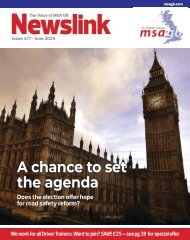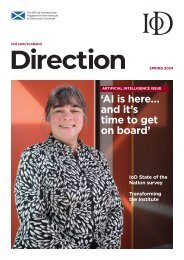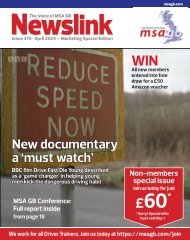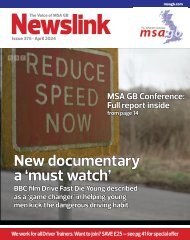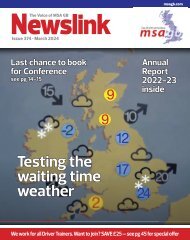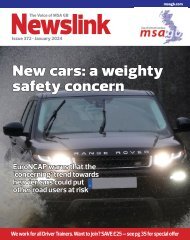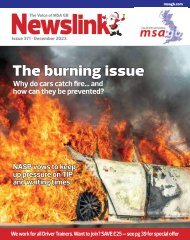Newslink January 2022
Motor Schools Association of Great Britain, driving instructors, ADIs, driver training and testing, road safety
Motor Schools Association of Great Britain, driving instructors, ADIs, driver training and testing, road safety
Create successful ePaper yourself
Turn your PDF publications into a flip-book with our unique Google optimized e-Paper software.
News<br />
ADIs have to take a lead in teaching all<br />
the public the new rules of the road<br />
Colin Lilly<br />
Editor, MSA GB <strong>Newslink</strong><br />
After a consultation last year, the<br />
Department for Transport has brought<br />
forward major changes to the Highway<br />
Code. These will be effective from 29th<br />
<strong>January</strong>, subject to Parliamentary approval.<br />
At the core of these changes is the<br />
establishment of a hierarchy of road<br />
users and the need for everyone using<br />
the road to behave responsibly.<br />
The hierarchy places pedestrians at the<br />
top, followed by cyclists, horse riders and<br />
horse-drawn vehicles. Following them<br />
are motor vehicles, in the order larger<br />
vehicles from vans and mini-buses to<br />
lorries and buses/coaches. The<br />
underlying principle is that the least<br />
vulnerable protect the most vulnerable.<br />
I am sure that the vast majority of<br />
driver trainers set this principle at the<br />
root of their training. The success of<br />
these changes relies on the existing<br />
driver’s acceptance. Many will have to<br />
change their attitude to other road users.<br />
During the consultation, 18 per cent<br />
disagreed on the need for a hierarchy of<br />
road users to be created, and on giving<br />
stronger priorities to pedestrians, 21 per<br />
cent disagreed. When dealing with<br />
priority to pedestrians waiting at<br />
junctions, 26.1 per cent disagreed.<br />
With opposition like that, the DfT may<br />
need to win over hearts and minds to<br />
make a success of these changes.<br />
Hierarchy of Road Users<br />
The ‘Hierarchy of Road Users’ is a<br />
concept that places those road users<br />
most at risk in the event of a collision at<br />
the top of the hierarchy. The hierarchy<br />
does not remove the need for everyone to<br />
behave responsibly. The road users most<br />
likely to be injured are pedestrians,<br />
cyclists, horse riders and motorcyclists,<br />
with children, older adults and disabled<br />
people being more at risk. The following<br />
‘H rules’ clarify this concept.<br />
Rule H1<br />
It is important that ALL road users are<br />
aware of The Highway Code, are<br />
considerate to other road users and<br />
understand their responsibility for the<br />
safety of others.<br />
Everyone suffers when road collisions<br />
occur, whether they are physically injured<br />
or not. But those in charge of vehicles<br />
that can cause the greatest harm in the<br />
event of a collision bear the greatest<br />
responsibility to take care and reduce the<br />
danger they pose to others. This principle<br />
applies most strongly to drivers of large<br />
goods and passenger vehicles, vans/<br />
minibuses, cars/taxis and motorcycles.<br />
Cyclists, horse riders and drivers of<br />
horse-drawn vehicles likewise have a<br />
responsibility to reduce danger to<br />
pedestrians. None of this detracts from<br />
the responsibility of ALL road users,<br />
including pedestrians, cyclists and horse<br />
riders, to have regard for their own and<br />
other road users’ safety.<br />
Always remember that the people you<br />
encounter may have impaired sight,<br />
hearing or mobility and that this may not<br />
be obvious.<br />
Rule H2<br />
Rule for drivers, motorcyclists, horse<br />
drawn vehicles, horse riders and cyclists<br />
At a junction you should give way to<br />
pedestrians crossing or waiting to cross a<br />
road into which or from which you are<br />
turning. You MUST give way to<br />
pedestrians on a zebra crossing, and to<br />
pedestrians and cyclists on a parallel<br />
crossing (Rule 195).<br />
Pedestrians have priority when on a<br />
zebra crossing, on a parallel crossing or<br />
at light-controlled crossings when they<br />
have a green signal.<br />
You should give way to pedestrians<br />
waiting to cross a zebra crossing, and to<br />
pedestrians and cyclists waiting to cross<br />
a parallel crossing.<br />
Horse riders should also give way to<br />
pedestrians on a zebra crossing, and to<br />
pedestrians and cyclists on a parallel<br />
crossing.<br />
Cyclists should give way to pedestrians<br />
on shared use cycle tracks and to horse<br />
riders on bridleways.<br />
Only pedestrians may use the pavement.<br />
Pedestrians include wheelchair and<br />
mobility scooter users. Pedestrians may<br />
use any part of the road and use cycle<br />
tracks as well as the pavement, unless<br />
there are signs prohibiting pedestrians.<br />
Rule H3<br />
Rule for drivers and motorcyclists<br />
You should not cut across cyclists,<br />
horse riders or horse-drawn vehicles<br />
going ahead when you are turning into or<br />
out of a junction or changing direction or<br />
lane, just as you would not turn across<br />
the path of another motor vehicle. This<br />
applies whether they are using a cycle<br />
lane, a cycle track, or riding ahead on<br />
the road and you should give way to<br />
them.<br />
08<br />
NEWSLINK n JANUARY <strong>2022</strong>







